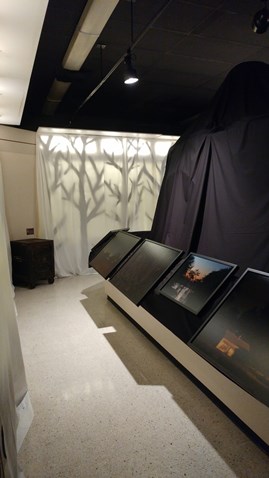
by Mary Rupert
Tonight, an opening night party will kick off the “Through Darkness to Light” exhibit at the Wyandotte County Museum, 621 N. 126th St., Bonner Springs, Kan.
The party, free and open to the public, will be from 6 to 8 p.m. Aug. 31 at the museum.
The exhibit is made up of photographs taken, mostly at night, of sites along the Underground Railroad, said David Hartman, museum curator. It runs through Oct. 10.
Jeanine Michna-Bales, the photographer, took the pictures at night to give viewers a realistic portrayal of what it was like for slaves to travel at night, seeking their freedom, he said.
In this exhibit, Michna-Bales, a photographic historian from Texas, followed the trail from Louisiana to Canada, stopping along the way in Indiana, Ohio and Michigan, Hartman said. She did not take photos in Kansas City, Kansas.
She took pictures of caves, trees and rivers that escaping slaves might have seen along their route. Also, she took photos of famous homes where slaves were assisted in their journey, and had a place to stay and eat, he said.
The museum’s east gallery has been transformed into a nighttime atmosphere, including sound effects of the forest, he added.
The Wyandotte County Museum will have companion artifacts from the Civil War era on display during this exhibit, he said. A Civil War cannon, a mask of President Abraham Lincoln, and a ball-and-chain that actually was used on a slave here are among the artifacts on display, he said.
Sometimes, homes that were stops along the Underground Railroad hung quilts on clothes lines or placed them on a railing outside the home, Hartman said. These quilts had symbols hidden in the patterns that helped direct slaves to a safe location, he added. One quilt will be on display at the museum.
Other artifacts from the old town of Quindaro, at 27th Street at the Missouri River, will be on display, he said. In the pre-Civil War era, escaping slaves would come across the Missouri River from Parkville, Mo., to Quindaro, because it was a free city. The city, founded by abolitionists, was demolished in 1866, it is believed, and the area is now the Quindaro Ruins. These artifacts were discovered in an excavation of the area in 1987 through 1990, he added.
About 30 objects that were unearthed from the Quindaro Ruins will be on display at the museum during this event, Hartman said. These include tools and dishes, along with photographs of the excavation, he added.
He said the exhibit has an educational value for residents.
“They’re going to learn more about slavery, the Underground Railroad, and how Kansas City took a part in that, as well as Quindaro city,” he said. “A lot of people know the street Quindaro, but don’t know a city called Quindaro, and where part of the Underground Railroad came through, where many people came through to gain their freedom from slavery.”
Hartman said he hopes this exhibit will bring more attention to the Quindaro Ruins, the Quindaro museum, and recent efforts to make the Quindaro Ruins a national landmark. Currently, visitors may see the Quindaro Ruins from the Quindaro Overlook, and private tours are available, he added.
The Wyandotte County Museum’s exhibit will be open to school groups and bus groups, as well as the public, through Oct. 10.
The museum, usually closed on the weekend, has special hours for Labor Day weekend, 9 a.m. to 4 p.m. Friday, 9 a.m. to 2 p.m. Saturday, noon to 4 p.m. Sunday, and 9 a.m. to 4 p.m. on Monday, Labor Day. Hours Mondays through Fridays are 9 a.m. to 4 p.m. There is no admission charge.
For more information, visit https://www.facebook.com/wycomuseum/.
